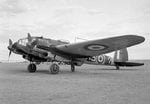This may be fact or it just might be a good story. I don't know.
well they were definitely different, whether that means better or not I can't say for certain but it sounds better - namely silver vs. copper based bearings and with some kind of special patented anti-corrosion coating made of indium.
The British took a while to approve higher than 9lbs boost for the Merlin XX although they did eventually get to to the 14lb and 16lb limits mentioned earlier. They were keeping the Merlin XX at 9lbs even though they were using 12lbs in the Melrn III.
The Americans stayed at 9lbs boost for quite some time although using 12lbs boost for take-off. It took until late 1942 and into early 1943 for the US to rate it's engines for WEP so many early manuals make no mention of it. I don't when or if the US "officially" raised the boost limits on the Merlin V-1650-1.
The official boost rating for P-40 F and L was 60" Hg in October of 1942. I'd be very surprised if the Spitfires or Hurricanes were staying below that. It seems likely that they boosted beyond that especially since we have pilot anecdotes of them outrunning Bf 109s at low altitude on more than one occasion.
There are also sometimes differences between what the factory says is OK and what the Government says is OK, P & W for instance rarely lists WEP power levels in company charts or tables even though we know both the navy and army used them.
yes we have the famous Allison memo on that.









